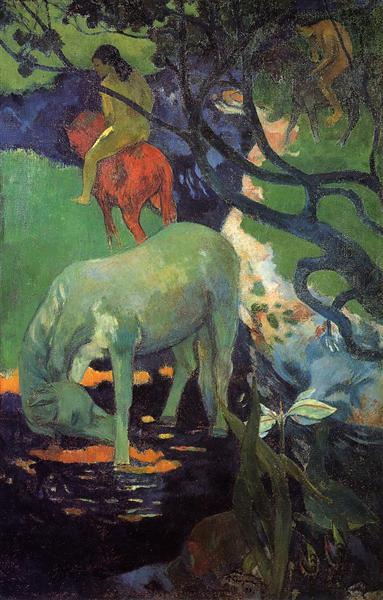Opis
W „The White Horse” z 1898 r. Paul Gauguin zachęca nas do zbadania jednej z jego najbardziej intrygujących kompozycji, w której jasność koloru i charakterystyczne poczucie formy zbiegają się, aby stworzyć sztukę, która kwestionuje konwencje jego czasów. Ta praca, charakteryzująca się jego żywą paletą i stylem post -impresjonistycznym, odzwierciedla zdolność Gauguina do uchwycenia esencji rzeczywistości poprzez interpretację emocjonalną i symboliczną.
Praca przedstawia białego konia, który jest centralnym elementem, starannie ułożonym w środowisku, które wydaje się wibrować własnym życiem. Powierzchnia płótna świeci ciepłymi i jasnymi tonami, w których biała zwierzęcia, podkreślająca subtelne cienie i kontury, wydaje się wyłania się z dna z niemal eteryczną jasnością. Kontrast z terenem, pomalowany na ziemskie i zielone tony, jest niezbędny do kompozycji, ponieważ ustanawia wizualny dialog między koniem i jego otoczeniem.
Gauguin używa koloru stosowanego w gęstych warstwach, co zagłębia się w teksturę farby i poprawia uczucie głębokości. W przeciwieństwie do najbardziej naturalistycznego podejścia impresjonizmu, użycie koloru w tej pracy nie ma na celu odtworzenia rzeczywistości, ale wywołanie emocjonalnej reakcji. Każdy pociąg do pędzla wydaje się impregnowany z celową intencją, w której kolory działają nie tylko do opisania, ale do komunikacji. Dominujące ciepłe tony dają uczucie spokoju, podczas gdy użycie cieni u konia dodaje objętości i wymiaru, prawie tak, jakby zwierzę było w momencie kontemplacyjnego odpoczynku.
Postać samego konia, z jego uproszczonymi formami i wyraźnymi konturami, jest emblematyczną reprezentacją stylu, który Gauguin zacząłby dokładniej badać w swojej karierze. Dzięki tej pracy widz zdaje sobie sprawę, że koń jest nie tylko prostym zwierzęciem, ale symbolem wolności i siły, powtarzającym się elementami w pracy artysty. Brak ludzkich postaci делает że podejście koncentruje się całkowicie na związku między koniem a krajobrazem, pozwalając naturze i postać koni, opowiedzieć własną historię.
Gauguin, który pociągnął do wysp Polinezji oraz jego żywych krajobrazów i prostych ludzi, dowody w tej pracy przejście do stworzenia bardziej duchowej i symbolicznej sztuki. W „The White Horse” natura w poetyckiej reprezentacji staje się odzwierciedleniem duszy, sugerując, że sztuka może być głębokim środkiem połączenia z wzniosłym. Chociaż ta konkretna praca nie jest tak dobrze znana jako inne z okresu, jest świadectwem jego ewolucji wobec symboliki i poszukiwania znaczeń poza widocznymi.
Podsumowując, „The White Horse” jest potężnym przykładem innowacyjnego podejścia Gauguina, w którym kolor, kształt i prostota są splecione w bogatej i sugestywnej ekspresji. W nim widz jest zaproszony do wizualnej podróży, która wykracza poza chwilę, penetrując królestwo emocji i symboliki, które definiują erę i artysta zaangażowany w poszukiwanie istoty istnienia. Podczas eksploracji tej pracy pamiętamy z siły sztuki do przekroczenia zwykłej reprezentacji, oferując okno na myśl i wrażliwość jednego z nauczycieli post -impresji.
KUADROS ©, słynna farba na ścianie.
Ręcznie wykonane obrazy olejne, z jakością profesjonalnych artystów i charakterystyczną pieczęcią KUADROS ©.
Usługa reprodukcji zdjęć z gwarancją satysfakcji. Jeśli nie jesteś w pełni zadowolony z repliki twojego obrazu, zwrócimy twoje pieniądze w 100%.

